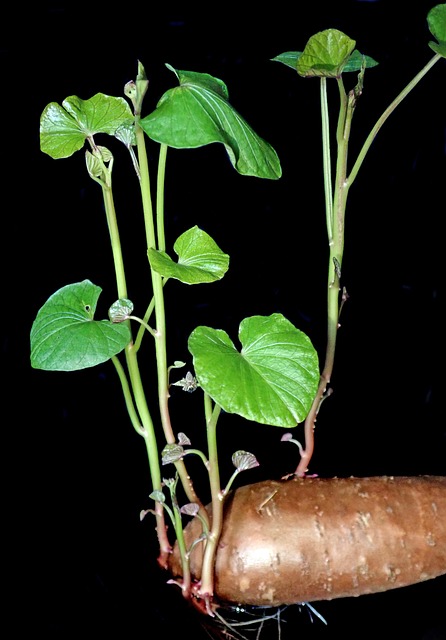Sweet potatoes are tubers that are native to South and Central America, yet it is also easy to grow them here in the UK! They are delicious when roasted in the oven or mashed, and are full of vitamin A. Thanks to the different varieties of sweet potato available, you can get a great harvest from your vegetable garden, especially if planted after the frost has passed.
Here’s how to grow sweet potatoes in the UK.

Getting Started with Sweet Potato Slips
Growing sweet potatoes in your garden is different from how you’d start with regular potatoes. To successfully grow sweet potatoes, you begin with a cutting, rather than as seeds or sets. Sweet potato cuttings are called ‘slips’.

Slips are small pieces of rooted sweet potato tuber, which can be planted directly into small pots with multi-purpose compost.
They are available to buy from any good garden stockist, or you can create your own by buying a sweet potato tuber and submerging it in a cup of water. Roots will form and these can be plucked off as slips. This is the best way to get lots of slips for planting!
A good time to plant them is from May onwards, when there’s no risk of a late frost.
Choose sweet potato varieties suited to the UK climate, such as Beauregard or Georgia Jet, as these varieties have been bred to perform well in cooler conditions.
When you receive your sweet potato slips, you must soak them in a bucket of water overnight to rehydrate them. Then plant them in a tall pot, using good quality compost and an equal amount of sharp sand. Keep them in a warm place.
Pot the sweet potato slips into bigger pots when you begin to see roots poking out of the bottom of the pot.
How to Grow Sweet Potatoes Outside
Sweet potatoes can be grown outdoors in a multi-purpose soil, but you will need a sheltered and sunny position. Fertile soil that is on the sandy side and is free-draining is preferable.
Raised beds are ideal for sweet potatoes, but they can also be planted in the ground. It is a good idea to create ridges to plant them in, as this helps prevent the soil from becoming waterlogged in wet weather.
Prepare the soil in advance by digging in some organic matter, such as garden compost or well-rotted manure.
Warm the soil before planting out sweet potatoes in April to ensure they grow well. A cloche placed over the soil will warm it well, or you can use polythene.
After soaking overnight, one sweet potato slip each be can be planted into its growing position, either under a cloche or planted through holes in the polythene.
Planting Sweet Potatoes
Before you plant out your sweet potatoes, they will need to get used to the outside temperature. Harden them off by putting the pots outside for increasing amounts of time over a week to ten days, after the last frost has passed to protect them from cold weather.
Sweet potato plants should be planted approximately 1 foot apart to ensure they have enough space to grow well. The foliage, similar to morning glory, grows like a vine, and can be trained to grow over canes or trellis, or it can grow along the ground.
Once the stems reach approximately two feet in length, pinch out the tip so the plant can use the energy into developing the tubers.

Growing Sweet Potatoes Indoors
Sweet potatoes prefer temperatures between 21°C and 26°C, so often growing them indoors in a greenhouse can be a better option. Pot them on into larger containers as required.
Caring for Sweet Potatoes
Once your sweet potato plants start sending out vines, train them along the ground to encourage the formation of new roots and multiple plants from one sweet potato.
Sweet potatoes need consistent moisture throughout the growing season to develop their characteristic orange flesh. Water regularly, especially during dry periods. However, it is essential to avoid overwatering, as sweet potatoes prefer slightly drier conditions.
Adding mulch around the plants will help to suppress weeds and also retain moisture in the soil.
Keep a close watch for slugs, snails, and other pests that believe sweet potatoes are grown just for them! If your plants start to get eaten, try some natural pest control methods.
Harvesting Sweet Potatoes
If planted in April, sweet potato should be ready to harvest in August and September. The leaves turning yellow is a good indication that they are ready. This is known as die back. Carefully lift the tubers with a fork.
Once lifted, brush off the excess soil and leave in a warm place for a week to allow the skins to harden, a crucial step since potatoes aren’t tough immediately after harvesting.
Sweet potatoes do not store well for long, so eat them fairly quickly.
Find out more about growing a variety of vegetables in Smallholding, A beginner’s Guide to Raising Livestock and Growing Garden Produce.
Sweet Potato FAQs
A: Sweet potatoes in the UK can be planted by using slips, which are young sweet potato plants grown from the sprouts of a mature sweet potato. It is recommended to plant them in a raised bed or in containers to ensure proper drainage and warm soil.
A: Some common varieties suitable for growing in the UK include Beauregard or Georgia Jet, which are suited to wetter and cooler conditions.
A: Sweet potatoes typically take around 100 days to mature and produce edible tubers after they are planted.
A: To ensure a good harvest, it is important to regularly pinch out the growing tips of the potato plant to encourage the development of more tubers. Additionally, sweet potatoes should be cured after harvesting to improve their flavor and storage quality.
A: Yes, sweet potatoes can be grown in a greenhouse in the UK to protect them from the risk of frost and to create an ideal environment for growing these warm-climate plants.
A: Yes, they can be propagated by taking cuttings from the vines and rooting them in water before planting them in soil to grow new plants.
A: Yes, they can be grown in containers, which is ideal for those with limited garden space or for those who want to control the soil conditions more effectively.
Do you have a preferred method of planting sweet potatoes to get the best yield? Please share in the comments!

